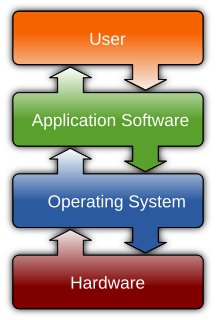This page is based on this
Wikipedia article Text is available under the
CC BY-SA 4.0 license; additional terms may apply.
Images, videos and audio are available under their respective licenses.

In mathematics and computer science, an algorithm is an unambiguous specification of how to solve a class of problems. Algorithms can perform calculation, data processing, automated reasoning, and other tasks.

Computer software, or simply software, is a collection of data or computer instructions that tell the computer how to work. This is in contrast to physical hardware, from which the system is built and actually performs the work. In computer science and software engineering, computer software is all information processed by computer systems, programs and data. Computer software includes computer programs, libraries and related non-executable data, such as online documentation or digital media. Computer hardware and software require each other and neither can be realistically used on its own.
In computability theory, the Church–Turing thesis is a hypothesis about the nature of computable functions. It states that a function on the natural numbers is computable by a human being following an algorithm, ignoring resource limitations, if and only if it is computable by a Turing machine. The thesis is named after American mathematician Alonzo Church and the British mathematician Alan Turing. Before the precise definition of computable function, mathematicians often used the informal term effectively calculable to describe functions that are computable by paper-and-pencil methods. In the 1930s, several independent attempts were made to formalize the notion of computability:

Kevin Warwick FIET, FCGI, is a British engineer and Deputy Vice-Chancellor (Research) at Coventry University in the United Kingdom. He is known for his studies on direct interfaces between computer systems and the human nervous system, and has also done research concerning robotics.
In computability theory, a system of data-manipulation rules is said to be Turing complete or computationally universal if it can be used to simulate any Turing machine. This means that this system is able to recognize or decide other data-manipulation rule sets. Turing completeness is used as a way to express the power of such data-manipulation rule set. The expression power of these grammars is captured in the Chomsky hierarchy. Virtually all programming languages today are Turing Complete. The concept is named after English mathematician and computer scientist Alan Turing.
In mathematics, logic and computer science, a formal language is called recursively enumerable if it is a recursively enumerable subset in the set of all possible words over the alphabet of the language, i.e., if there exists a Turing machine which will enumerate all valid strings of the language.

The Mind's I: Fantasies and reflections on self and soul is a 1981 collection of essays and other texts about the nature of the mind and the self, edited with commentary by philosophers Douglas R. Hofstadter and Daniel C. Dennett. The texts range from early philosophical and fictional musings on a subject that could seemingly only be examined in the realm of thought, to works from the twentieth century where the nature of the self became a viable topic for scientific study.
In computability theory, a probabilistic Turing machine is a non-deterministic Turing machine which chooses between the available transitions at each point according to some probability distribution.
"Computing Machinery and Intelligence" is a seminal paper written by Alan Turing on the topic of artificial intelligence. The paper, published in 1950 in Mind, was the first to introduce his concept of what is now known as the Turing test to the general public.
Computability is the ability to solve a problem in an effective manner. It is a key topic of the field of computability theory within mathematical logic and the theory of computation within computer science. The computability of a problem is closely linked to the existence of an algorithm to solve the problem.
In mathematical logic and theoretical computer science a register machine is a generic class of abstract machines used in a manner similar to a Turing machine. All the models are Turing equivalent.
Artificial intelligence has close connections with philosophy because both share several concepts and these include intelligence, action, consciousness, epistemology, and even free will. Furthermore, the technology is concerned with the creation of artificial animals or artificial people so the discipline is of considerable interest to philosophers. These factors contributed to the emergence of the philosophy of artificial intelligence. Some scholars argue that the AI community's dismissal of philosophy is detrimental.
A Post–Turing machine is a "program formulation" of an especially simple type of Turing machine, comprising a variant of Emil Post's Turing-equivalent model of computation described below. A Post–Turing machine uses a binary alphabet, an infinite sequence of binary storage locations, and a primitive programming language with instructions for bi-directional movement among the storage locations and alteration of their contents one at a time. The names "Post–Turing program" and "Post–Turing machine" were used by Martin Davis in 1973–1974. Later in 1980, Davis used the name "Turing–Post program".

The following article is a supplement to the article Turing machine.
A computer is a device that can be instructed to carry out sequences of arithmetic or logical operations automatically via computer programming. Modern computers have the ability to follow generalized sets of operations, called programs. These programs enable computers to perform an extremely wide range of tasks. A "complete" computer including the hardware, the operating system, and peripheral equipment required and used for "full" operation can be referred to as a computer system. This term may as well be used for a group of computers that are connected and work together, in particular a computer network or computer cluster.









